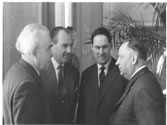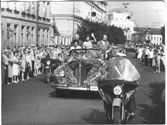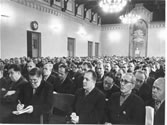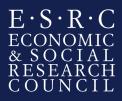About the Project

The First Secretary of the Estonian Communist Party, I.G. Kebin, talking to leading cultural figures (1963)
Description of Project
Research Objectives
From the late Stalin period the status of regional party secretaries in the Soviet political system steadily grew, so that under Brezhnev they had become, alongside their republican counterparts, the most important category of officials in the USSR save for the supreme leadership itself. As well as being an important category in its own right, the regional First Secretaryship was the main avenue for upward mobility in the Soviet political system. Among Brezhnev-era incumbents of this post, were a number, such as Mikhail Gorbachev and Boris Yeltsin, who would go on to positions of national prominence. The purpose of this project is to make use of a vast but unused source to assess the changing role of the regional First Secretary over three distinct phases of Soviet rule. In so doing, we aim to shed light on broader issues relating to the nature and evolution of the Soviet state. In particular, concentration on the First Secretary and on his informal relations with clients and enemies should allow us to penetrate into the heart of regional political networks and to assess the structure—whether it be unified, balanced or fragmented—of the regional political elite. In addition, by focusing on the First Secretary, the most important node connecting the Central Committee to the regional party committee (the obkom), we aim to deepen our understanding of the formal system of Soviet patronage, the nomenklatura.
Aims of the Research
- To describe the formation and structure of regional networks and to assess the effects of such networks on central management of the provinces.
- To provide a typology of regional elites, based on whether they were unified, balanced or fragmented.
- To deepen our understanding of the formal system of Soviet patronage, the nomenklatura.

Hometown parade in honour of the first ever woman Cosmonaut, V.V. Tereshkova, who is flanked on her left by the First Secretary of the Yaroslavl obkom, F.I. Loshchenkov, and on her right by the Chair of the oblispolkom, V.F. Toropov (6 July 1963)
Approach
Central to our method is a focus on conflict. Although politicians were ordinarily very reserved and secretive about the presence of networks and patronage groups in their region, the lineaments of these networks were usually laid bare during scandals, as regional battle-lines were drawn, as clients sought protection from patrons, and as higher level investigations revealed the webs of protection and mutual assistance which ran through a region. As in our recent book (Gorlizki and Khlevniuk, Cold Peace: Stalin and the Soviet Ruling Circle, 1945-1953 (New York: Oxford University Press, 2004, chaps 1, 3, 4)), we shall focus on moments of crisis and scandal in order to illuminate the dynamics of the regional power system. For this purpose the information collected from a pilot study conducted in 2003-4, on dismissals of regional First and Second Secretaries and on the reasons for these dismissals (scandals and amoral behaviour, incompetence, and natural turnover) will serve as a key starting point (see right-hand column, Appendixes A and B and Archive Based Materials 1). Information on networks presented by these crises will then be checked against the patterns of everyday correspondence and communication in the region. At the same time, we shall correct for the potential bias in our approach by including six regions which were politically “calm” and relatively free of scandal.
We concentrate on 28 regions which, in turn, are sub-divided into three groups. The first group of four regions (see Appendix A) will involve intensive analysis of regional archives. In these regions we shall carry out an exhaustive study of local repositories to provide a picture of everyday working practices and to build a full narrative sequence of events over the period. This will be complemented with a more wide-ranging examination of 24 regions (see Appendices B and C, the latter of which is based on research carried out since the beginning of the project in March 2005), based on analysis of materials from the sektor informatsii in the Central Party Archives in Moscow.

Meeting of the party aktiv of Sverdlov district, Leningrad, being addressed by the First Secretary of the Leningrad obkom, I. V. Spridonov (1958)
Scope
As an archival study, the limits of the project will be set by what we can reasonably expect to obtain from the archives. We begin in the immediate post-war period, because it was then that Stalin sought to integrate regional expertise in the central management of the provinces (by bringing former provincial First Secretaries en masse to the Orgburo and to the new Administration for Checking Party Organs) and it was in this period too, that a clear ladder of nomenklatura positions and a regularized system of cadre movements and transfers was established. The historical end-point for the project is set by two parameters. By 1970 the new leadership system associated with Leonid Brezhnev was fully established. Further, given the thirty-year rule currently in operation, we can be confident of obtaining archival materials until the cut-off date of 1970. The time span from 1945 to 1970 will thus allow us to cover a 25 year phase which includes the transition from Stalin to post-Stalin rule, and the consolidation of the regional system under Brezhnev.
Appendix A
Region |
Zone |
Population |
Urban/ rural |
Ethnicity3 |
Industrial Economy2 |
Admin status |
Turnover & reasons1 |
Cheliabinsk |
Urals |
3.09m |
77/23 |
81R/6T |
50mb/21fm |
oblast |
S (1950) I (1954/61) |
Moscow |
Central |
4.94m |
59/41 |
94R/3U |
41mb/22li |
oblast |
S (1949) |
Penza |
Volga |
1.53m |
36/64 |
86R/6M |
65mb |
oblast |
I (1961) |
Vinnitsa |
SW Ukr |
2.16m |
18/82 |
89U/6R |
45mb/14li |
oblast |
Q |
Notes: Figures are for 1961, the mid-point of our study, for 2nd, 3rd and 4th columns, and for the 1980s for the 5th and 6th columns. Abbreviations are as follows: 1 S = scandals and amoral behaviour; I = incompetence; Q = natural turnover (health and retirement); 2 mb=machine building; fm = ferrous metals; li = light industry; w= woodwork and paper; f=fuels; m=ferrous metals; fp = food processing; c = chemical and petrochemicals 3 R = Russian, T = Tatars, U = Ukrainiains, M = Mordvins, K = Kazakhs, B = Belorussians, A = Azeris, C = Chuvash, E = Estonians, Kb = Kabardins, G = Germans, Ar = Armenians, Ta = Tadjik, Uz = Uzbek.
Appendix B
Region |
Zone |
Population |
Urban/ rural |
Ethnicity |
Industrial Economy |
Admin status |
Turnover & reasons |
Azerb’djan |
Caucasus |
3.97m |
49/51 |
83A/6R |
29mb/25li |
U/R |
n/a |
Chuvash |
V/Viatka |
1.14m |
26/74 |
68C/27R |
53mb/18li |
ASSR |
Q |
Dnepr’vsk |
Don/D’r |
2.85m |
72/28 |
72U/24R |
37mb/32m |
oblast |
n/a |
Estonia |
Baltics |
1.22m |
58/42 |
62E/30R |
28mb/20li |
U/R |
n/a |
Gomel’ |
Belor’sia |
1.39m |
31/69 |
80B/12R |
43mb/15li |
oblast |
n/a |
Gor’kii |
V/Viatka |
3.66m |
55/45 |
95R/2T |
61mb/8li |
oblast |
I (1950) |
Irkutsk |
E Sib’a |
2.09m |
64/36 |
89R/3U |
30w/25mb |
oblast |
Q |
Kab’no-B’ria |
N Cauc’s |
0.46m |
40/60 |
58Kb/32R |
47mb/20li |
ASSR |
Q |
Kemerovo |
W Sib’a |
2.9m |
78/22 |
91R/2U |
34f/21mb |
oblast |
I (1960) |
Khabarovsk |
Far East |
1.15m |
76/24 |
86R/6U |
45mb/17w |
krai |
Q |
Kirov |
V/Viatka |
1.84m |
41/59 |
90R/3T |
42mb/24w |
oblast |
S (1961) |
Kostroma |
Central |
0.92m |
43/57 |
96R/1U |
35mb/24w |
oblast |
I (1946/50 |
Krasnodar |
N Cauc |
3.91m |
40/60 |
85R/4U |
35mb/15li |
krai |
I (1960) |
Kursk |
C Ch’zm |
1.51m |
23/77 |
97R/2U |
41mb/14li |
oblast |
Q |
Novosibirsk |
W S’bria |
2.38m |
58/42 |
92R/2G |
61mb/11li |
oblast |
Q |
Orel |
Central |
0.94m |
27/73 |
97R/1U |
61mb/9li |
oblast |
Q |
Perm |
Urals |
3.04m |
61/39 |
84R/5T |
39mb/17w |
oblast |
I (1954) |
Riazan’ |
Central |
1.46m |
33/67 |
96R/1U |
59mb/13li |
oblast |
S (1949/60) |
Rostov |
N Cauc. |
3.45m |
59/41 |
90R/4U |
48mb/13f |
oblast |
I (1952) |
Samarkand |
Uzbek |
1.17m |
29/71 |
n/a |
31li/25mb |
oblast |
n/a |
Sem’pl’tnsk |
Kazakh |
0.61m |
42/58 |
n/a |
37li/20mb |
oblast |
n/a |
Stavropol |
N Cauc |
1.97m |
33/67 |
78R/3Ar |
39mb/19li |
krai |
I (1946/60) |
Sverdlovsk |
Urals |
4.15m |
77/23 |
89R/4T |
50mb/15f |
oblast |
Q |
Tadjikistan |
C Asia |
2.12m |
34/66 |
54Ta/23Uz |
39li/mb20 |
U/R |
n/a |
Tiumen’ |
W Sib’a |
1.12m |
35/65 |
73R/8U |
29mb/17w/16f |
oblast |
S (1955/61) |
Tula |
Central |
1.9m |
63/37 |
95R/2U |
48mb/12c |
oblast |
I (1953/55) |
Notes: As in Appendix A

